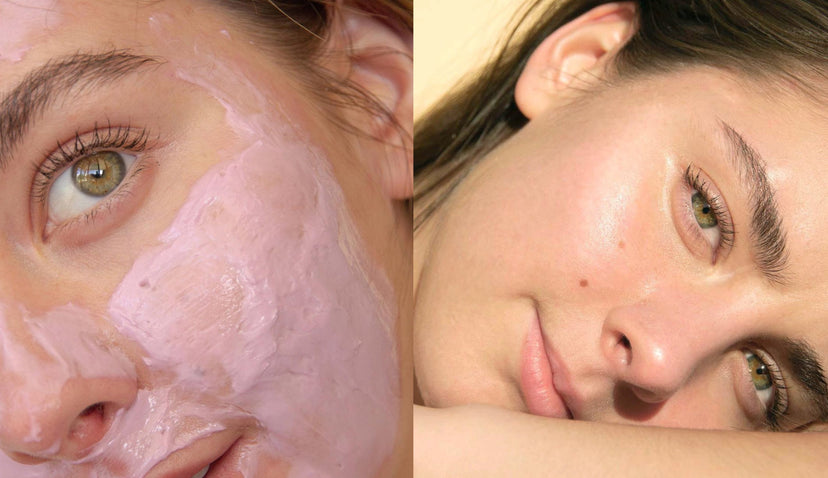The foundation of glowing, youthful-looking skin, skin cell turnover is a biological process that goes on in each of us, every minute of every day. Essentially, it involves our dead skin cells being shed and replaced by new ones approximately every 4-6 (ish) weeks.
The length of your own skin cycle will depend on your age and other lifestyle factors. However, rest assured you CAN give mother nature a gentle push. Because why would you want to hang onto dry, dull skin longer than you have to?
So, to discover how to hack your skin cycle and speed up cellular turnover for a fresh and healthy glow – read on!
What is cellular turnover – and how does it work?
Cellular turnover is simply the ongoing process of shedding dead skin cells and replacing them with fresher, younger cells. On a more scientific level, new skin cells (or keratinocytes) are produced in the stratum basale – the deepest layer of the epidermis. As they mature, these cells migrate to the very surface of the skin (stratum corneum), dislodging older, duller cells (corneocytes). And giving the complexion a radiance-boosting refresh.
So, how long does this shedding process take? Depending on age and other individual factors, you’ll wait 28-56 days for your epidermis to fully turn over1,2. However, this vastly varies through the decades – which we discuss in detail below.
How does cellular turnover change as we age?
As anyone 30-plus will attest, skin ageing is real. Firstly, our natural stores of collagen and hyaluronic acid will start to deplete, resulting in volume loss and lines. Our epidermis (outer skin layer) also thins – and our rate of skin cell turnover slows3. This means it takes longer for dull, rough skin cells to flake off and be replaced with fresh-and-juicy new ones.
Just how dramatically does cell turnover decline? Let's look at the numbers.

What impact does this have on your skin’s appearance?
As you age and your epidermis turns over more slowly, skin can become drier, rougher, and less even, with more visible pores. With dead skin cells outstaying their welcome, your skin will be less radiant, with more prominent fine lines and wrinkles. You may also experience hyperpigmentation – darkened patches of skin.
Additionally, that corneocyte congestion on your face could lead to pore blockages and pesky breakouts.
What can slow cellular turnover – other than age?
While ageing is hands down the key cause of sluggish cell turnover, other factors can also slow things down. Even in your early 20s. These include things like lack of sleep (guilty), excess UV exposure, smoking, stress, hormones and a dodgy diet.
Acne’s another one. People with acne are known to have “altered shedding (desquamation) of the epithelium”. Meaning? The natural skin turnover process in acne-prone skin is impaired. As dead skin cells aren’t shed as easily, pores can become clogged. And this, in turn, can trigger those unwanted blackheads and breakouts. Ever heard of adult acne?
How do I improve my skin’s cellular turnover?
Here’s the good news. Even if you do absolutely nothing, your skin will keep on turning over. But you can definitely give it a helping hand to renew itself sooner. So you can benefit from glowier skin.
To bring those dewy new skin cells to the surface, regular exfoliation is your BFF. You can do this using either a manual scrub or chemical exfoliant. The first works in a straightforward way, physically sloughing away dead skin cells. A chemical exfoliant, on the other hand, works by dissolving the intercellular glue that keeps dead skin cells lingering. Popular chemical exfoliants include glycolic and lactic acid (both types of alpha-hydroxy acid).
It’s important not to over-exfoliate, though, as this can damage the skin barrier. If your skin is sensitive, an enzymatic exfoliator, like our Australian Glow Berries Enzyme Powder Polish, is a great option. Powered by papaya fruit enzymes, Australian Quandong and Davidson Plum, it gently and effectively resurfaces the skin – with none of the irritation associated with the more aggressive AHAs.
Another gold-star ingredient to accelerate turnover is retinol. However, take care when introducing this stimulating active into your routine as it has the potential to cause irritation and dryness.
How else can I boost my glow?
While boosting skin cell turnover is the fast track to radiance, there are other ways to keep skin looking youthful – and maximise that glow. Hydration is essential to maintain the skin barrier and fight dullness, and Vitamin C is your glow-to brightening active.
Formulated with 5 types of hyaluronic acid plus Vitamin C from Kakadu Plum, Glow BerriesTM and 3-O-Ethyl Ascorbic Acid, our antioxidant-charged Super Bounce Mask brings back the bounce. Use 2-3 times a week for deeply hydrated, plump and radiant skin in just 10 minutes.
Or, for everyday hydration, glow and antioxidant protection, try our Dreamy Glow Drops. Finally, remember to top everything off with a moisturiser to seal all the goodness in! Our Intense Glow Moisturiser actively protects your skin from cell-damaging free radicals and visible signs of premature aging. Tip: Use our Enzyme Powder Polish first to remove dead skin cells and supercharge absorption of our brightening actives.
The bottom line
For skin to look its best at any age, make sure your routine includes products that gently encourage cellular turnover. Alongside regular (and gentle) exfoliation, also add brightening ingredients like Vitamin C into your day.
Want an instant megawatt glow? Shop our Australian Glow Berries range now.
Written and edited by: Pip Jarvis & Celeste



